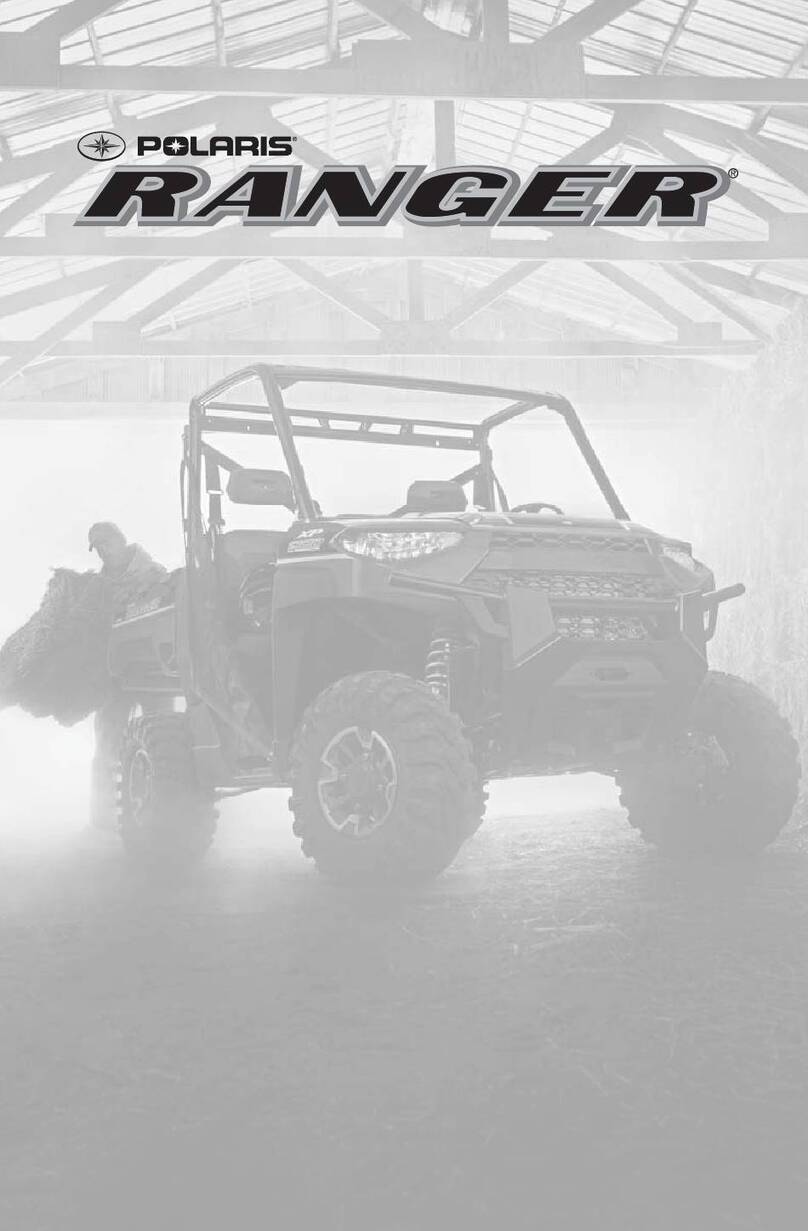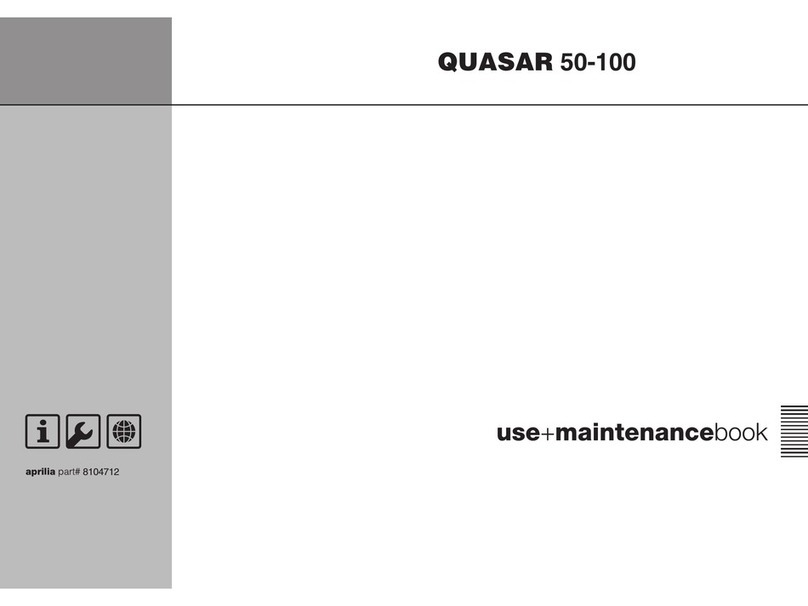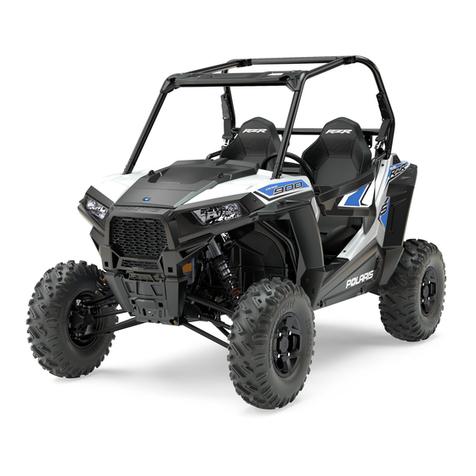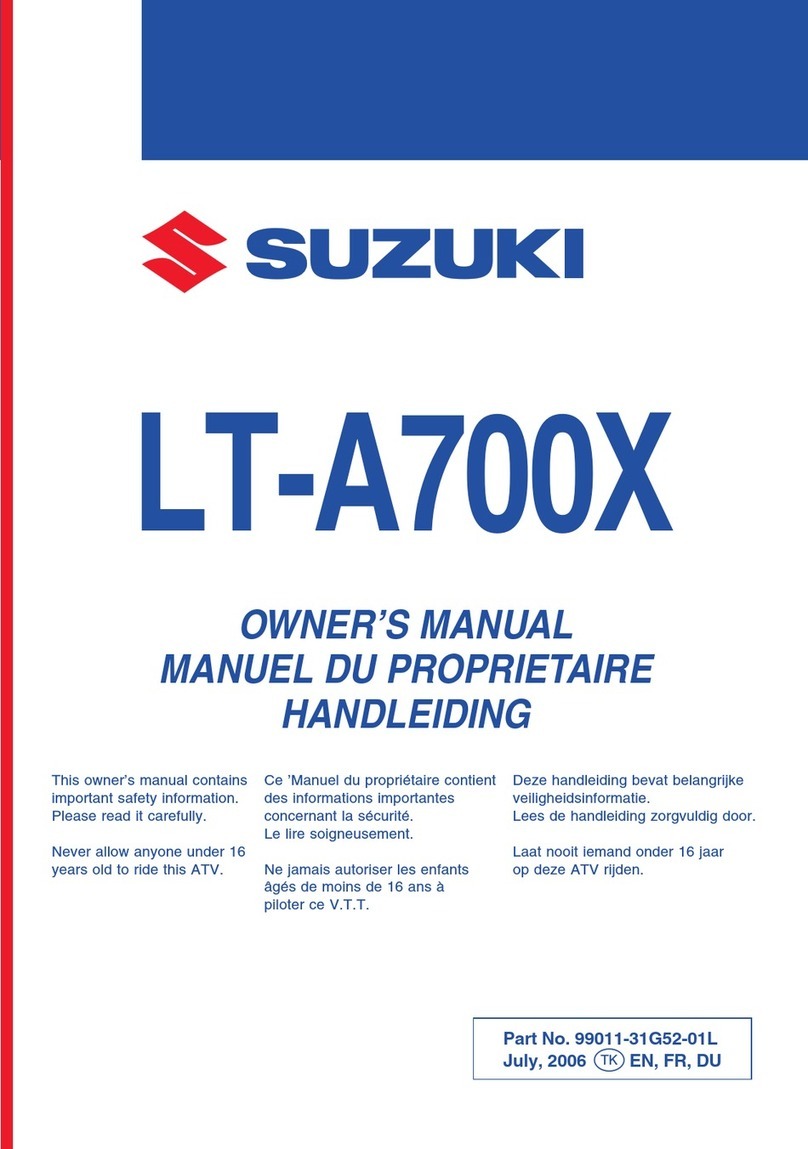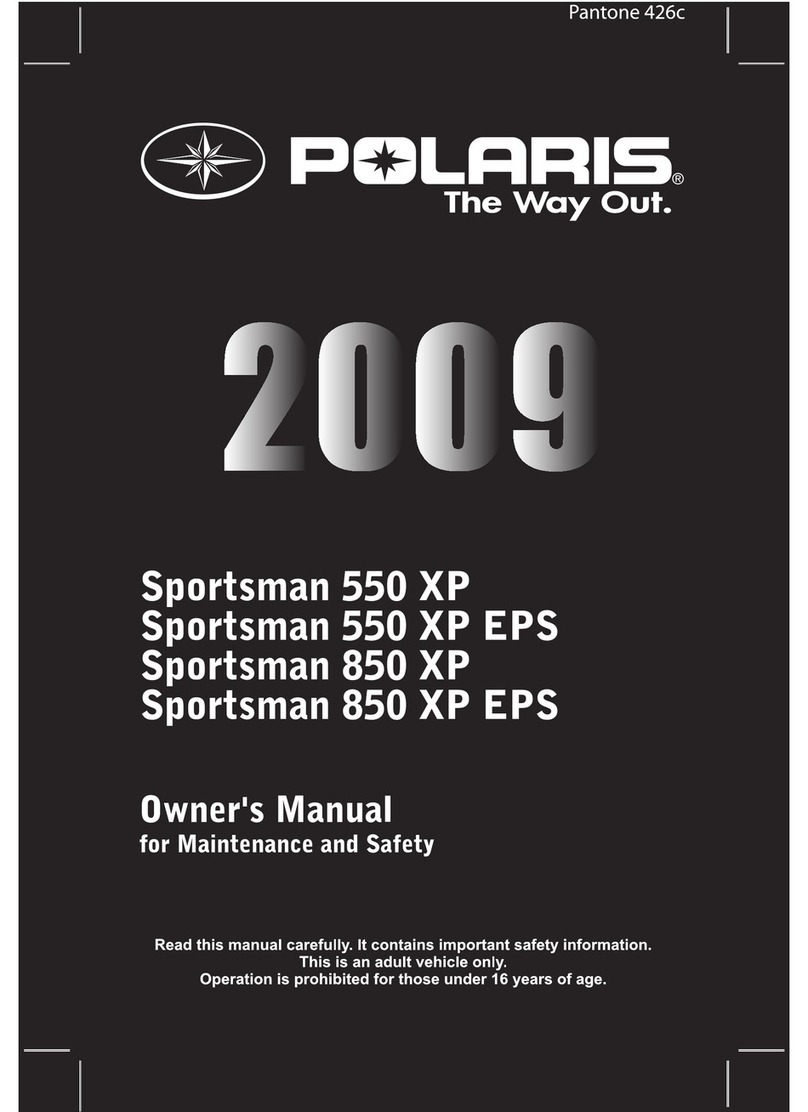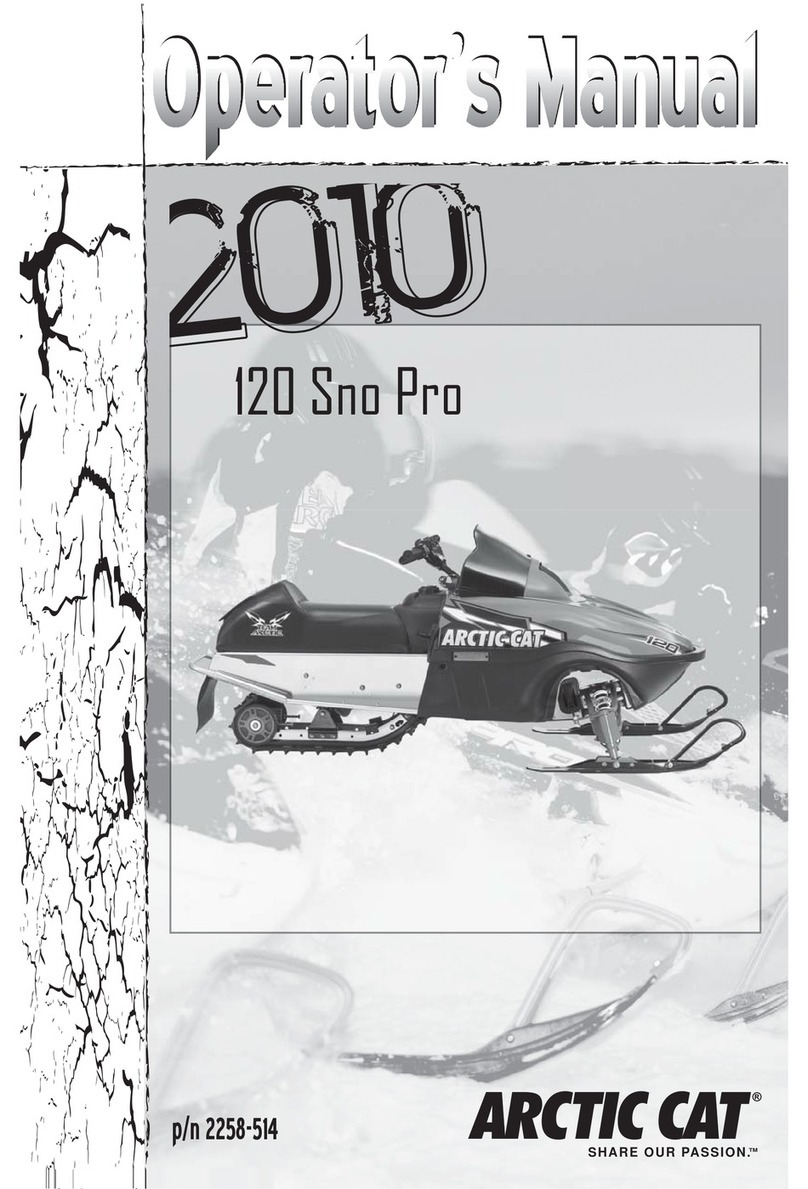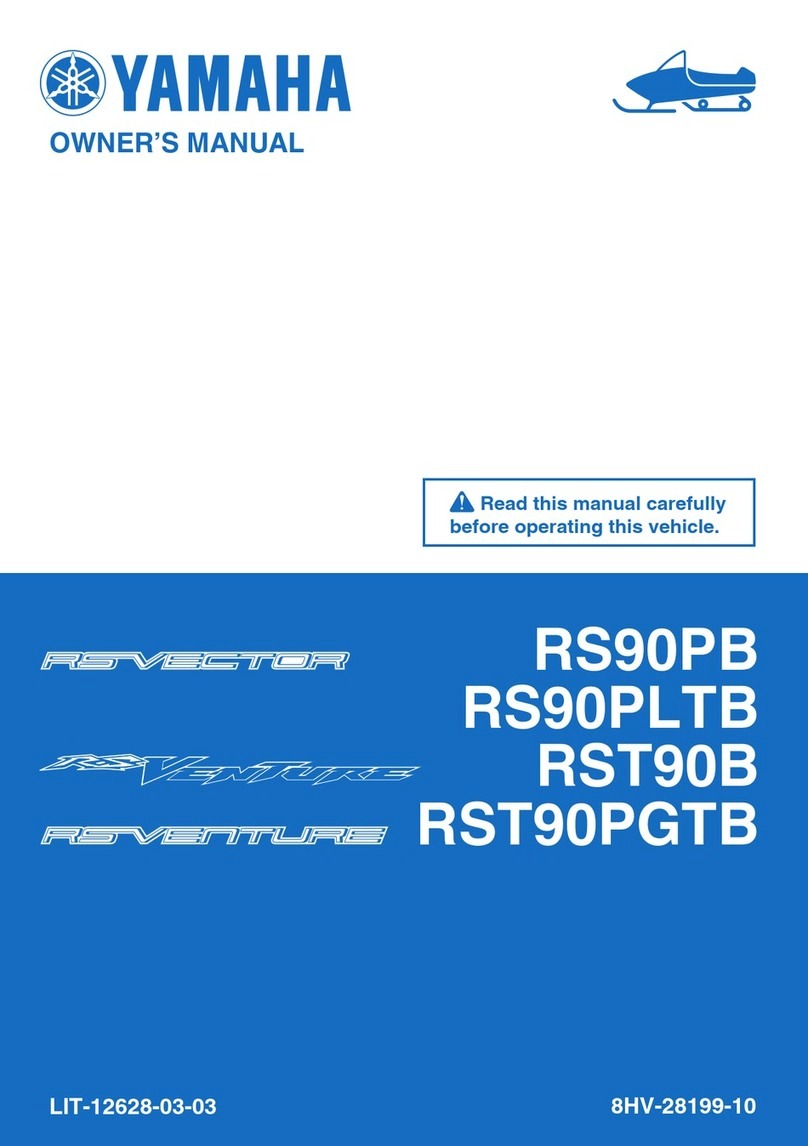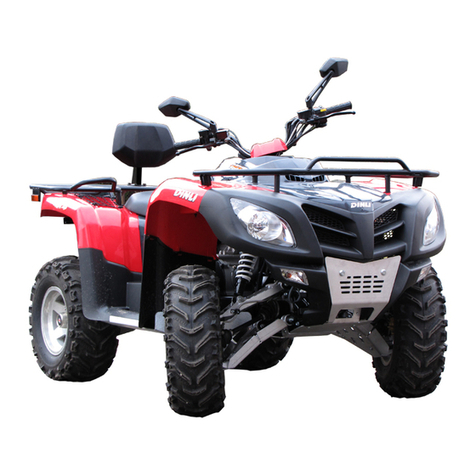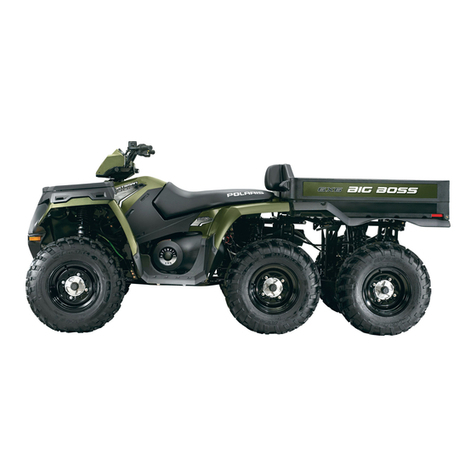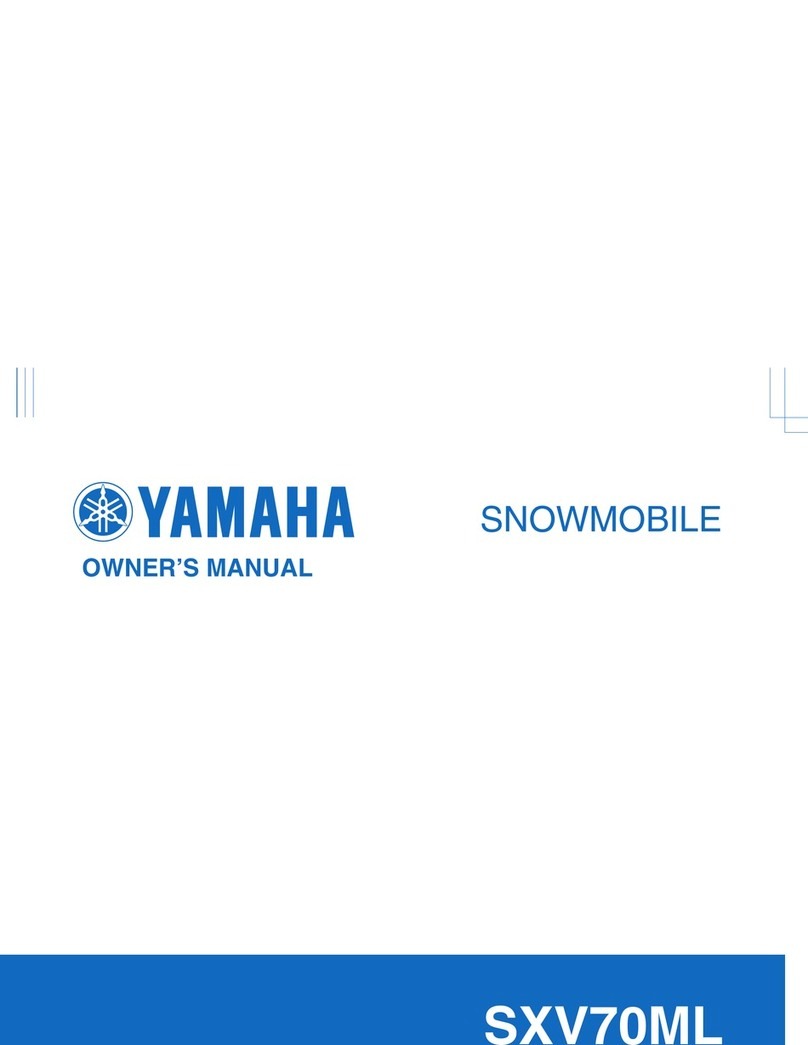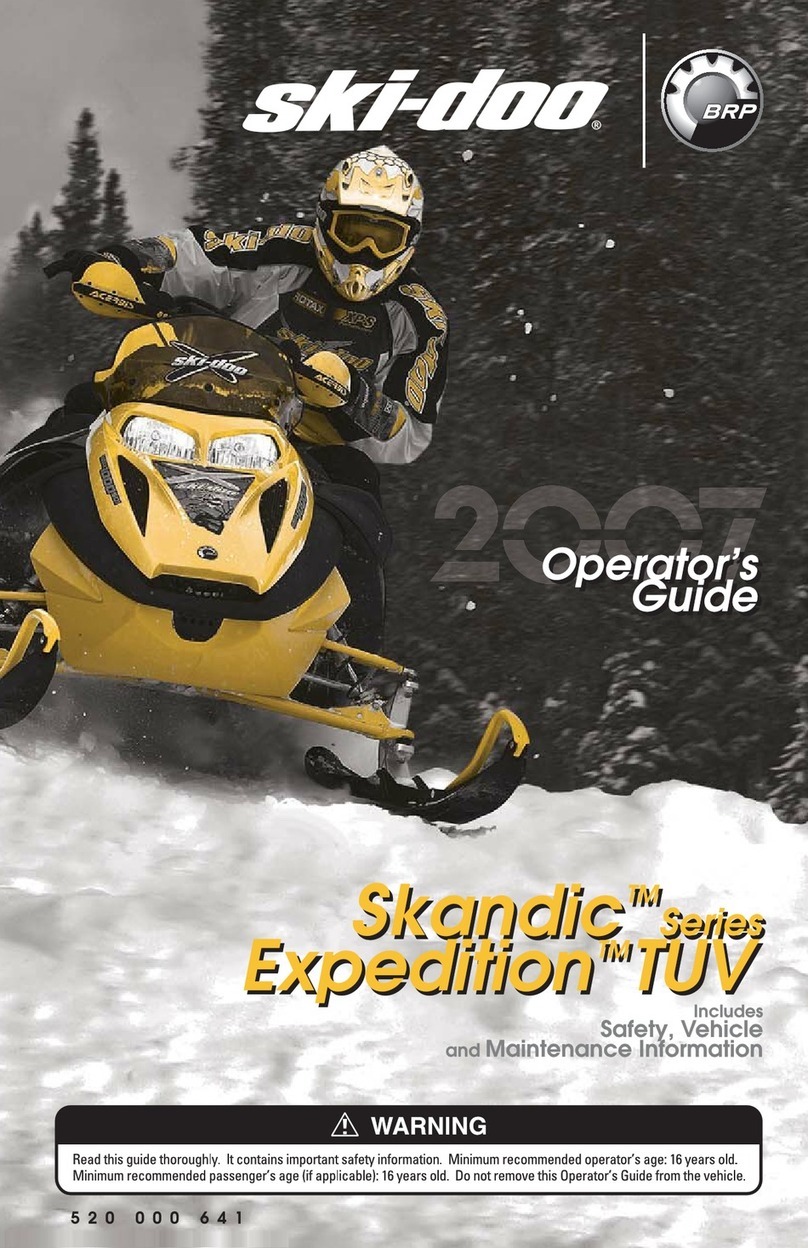SSR Motorsports GKV200 User manual

OWNER′S MANUAL
PLEASE CHECK YOUR LOCAL RIDING LAWSAND
REGULATIONS BEFORE OPERATING THIS VEHICLE.
This UTV should not be ridden by anyone under 10 years of age.
215mm*140mm
READ THIS MANUAL CAREFULLY
BEFORE YOU USE THIS VEHICLE!
It contains important safety information.

WARNING
Operation of this UTV by children under the age of 10 increase if the risk of severe injury or death.
An adult supervision required always.
Never permit children under age 10 to operate this UTV.
Overloading can adversely affect vehicle handling.
Operator use only, passengers prohibited.
This vehicle is designed and manufactured for OFF-ROAD use only.
Driving on public streets roads or highways is illegal.
Always wear helmet and other protective equipment.
Do not operate this vehicle after consuming Alcohol Drugs.
Gasoline flammable, when refueling. Please shut off engine to avoid sparks and open flame.
Read owner’s manual carefully before riding. Keep owner’s manual with vehicle.
WARNING
Read, understand, and follow all of the instructions and safety precautions in this manual and on all
product labels.
Failure to follow the safety precautions could result in serious injury or death.
WARNING
The engine exhaust from this product contains chemicals known to the State of California to cause
cancer, birth defects or other reproductive harm.
1
PAY ATTENTION TO YOUR SAFETY
This section presents some of the most important information and recommendations to help you ride your
UTV safely. Please take moments to read these pages. This section also includes information about
the location of safety labels on your UTV.
Important safety information
Your UTV can provide many years of service and pleasure-if you take responsibility for your own safety and
understand the challenges you can meet while riding.
There is much that you can do to protect yourself when you ride. You’ll find many helpful recommendations
throughout this manual. The following are a few that we consider most important.
Follow the age recommendation
The minimum recommended age of this UTV model is 10.Children under age 10 should never operate this
vehicle.
Always wear a helmet
It’s a proven fact: helmets significantly reduce the number and severity of head injuries. So always wear an
approved motorcycle helmet. We also recommend that you wear eye protection, sturdy boots, gloves, and
other protective gear.
Ride off-road only
Your UTV is designed and manufactured for off-road use only. The tires are not made for pavement, and the
UTV does not have turn signals and other features required for use on public roads. If you need to cross a
paves or public road, get off and walk your UTV across.
Take time to learn & practice
Even if you have ridden other UTV, take time to become familiar with your skills and get accustomed to the
UTV’s size and weight.
Because many accidents involve inexperienced or untrained riders, we urge all riders to take a training
course approved by the UTV safety institute.
2

Contact an authorized UTV dealer to find out about the training courses nearest you.
Be alert for off-road hazards
The terrain can present a variety of challenges when you ride off-road.
Continually “read” the terrain for unexpected turns, drop-offs, rocks ruts, and other hazards. Always keep
your speed low enough to allow time to see and react to hazards.
Ride within your limits
Pushing limits is another major cause of UTV accidents. Never ride beyond your personal abilities or faster
than conditions warrant.
Remember that alcohol, drugs, fatigue, and inattention can significantly reduce your ability to make good
judgments and ride safely.
Don’t drink and ride
Alcohol and riding don’t mix. Even one drink can reduce your ability to respond to changing conditions, and
your reaction time gets worse with every additional drink. So don’t drink and ride, and don’t let your friends
drink and ride either.
Keep your UTV in safe condition
It’s important to keep your UTV properly maintained and in safe riding condition. Having a breakdown can be
difficult, especially if you are stranded off-road far from your base. To help avoid problems, inspect your UTV
before every ride and perform all recommended maintenance.
Your UTV comes with a hangtag and several labels containing important safety information. Anyone who
rides the vehicle should read and understand this information before riding.
The labels should be considered permanent parts of the vehicle. If a label comes off or becomes hard to read,
contact your dealer for replacement. 3
GUIDELINES ON SAFE DRIVING
1. When approaching corners or bends to reduce speed. Upon the completion of turn, may gradually
increase the speed.
2. When crossing of turn, may gradually increase the speed.
3. Brake hose may be wet and useless so before walking away you should check all the brake system
and clean the ends.
4

INSTRUMENTS & CONTROLS
This section shows the location of all indicators and controls you would normally use before or while riding
your UTV.
These items listed on this page are described in this section. Instructions for other components are
presented in other sections of this manual where they will be most useful.
5
WELCOME
Dear parents:
We believe your children should have the opportunity to enjoy The Way Out, experience along with you. We
encourage you to teach your children to ride safely, and to help ensure the future of recreational sports,
please teach them to show respect for our environment and for the rights of others while operating the
vehicle.
This vehicle is not a toy and can be hazardous to operate. We’ve provided this owner’s manual to help you
and your children learn about the safe operation and care of your new vehicle. Before your children drive or
ride in the vehicle, please read and make sure they read the owner’s manual. Make sure they understand
that the vehicle must be used under adult supervision at all times.
After reading the owner’s manual, help your child practice the New Operator Driving Procedures on pages
47-48.
Never allow a child age 10 and under to operate or ride as a passenger In this vehicle. Children differ in shills,
physical abilities and Judgment.
Please supervise the use of the vehicle at all times. Permit continued use only if you determine that your
child has the ability and maturity to operate safely.
Make sure your child is not too tall to ride safely in this vehicle. See page 17.The vehicle’s speed control
system allows limiting vehicle speed for new and inexperienced operators. Please see page 40 for more
information. The preventive maintenance program outlined in this manual is designed to ensure that all
critical components on your child’s vehicle are thoroughly inspected at specific intervals. Always all of the
instructions and recommendations in this manual to ensure the vehicle remains in safe operating condition at
all times.
6

Your vehicle is not designed for adult use. Serious damage may occur if the maximum weight capacity is
exceeded. Refer to vehicle labels and to the specifications section beginning on page 97 for the maximum
weight capacity.
Dear Young Operators:
Before you ride your new vehicle, there are some important things that you need to know. You must learn
how to keep yourself and those around you safe while you’re riding.
You parents want you to be safe while you enjoy riding your new vehicle, and that’s why it’s very important
that you read this owner’s manual. Make sure you understand and follow all of the instructions and warning
in the owner’s manual. Ask your parents to explain anything you don’t understand.
Your safety and the safety of others is the most important thing to think about at all times. Pay attention you
see this symbol:
This is the safety alert symbol. When you see this symbol on your vehicle or in this manual it means
PAYATTENTION because you could die or be seriously injured if you don’t follow the instructions.
After reading the owner’s manual, complete the New Operator Driving Procedures on pages 47-48. Show
your parent that you understand how to drive safely.
Enjoy riding your new vehicle!
7
TABLE OF CONTENTS
Introduction.............................................................................11
Safety................................................................................... 14
Features and Controls............................................................29
Operation.............................................................................. 41
Emission Control Systems.....................................................57
Maintenance........................................................................... 58
Specifications.........................................................................97
Troubleshooting......................................................................99
Maintenance Log....................................................................103
YOUR WARRANTY RIGHTS AND OBLIGATIONS…………………………..104
8

INTRODUCTION
The following signal words and symbols appear throughout this manual and on your vehicle. Your safety is
involved when these words and symbols are used. Become familiar with their meanings before reading the
manual.
The safety alert symbol indicates a potential personal injury hazard.
WARNING
AWARNING indicates hazardous situation which, if not avoided, may result death or serious injury.
CAUTION
A CAUTION indicates a hazardous situation which, if not avoided, may result death or serious injury.
CAUTION
A CAUTION indicates a hazardous situation which, if not avoided, may result in minor or moderate injury.
NOTICE
A NOTICE indicates a situation that may result in property damage.
The Prohibition Sign indicates an action NOT to take in order to avoid a hazard.
The Mandatory Action Sign indicates an action that NEEDS to be taken to avoid a hazard.
9
INTRODUCTION
! WARNING
Failure to follow the warnings and safety precautions contained in this manual can result in severe injury or
death. Your vehicle is not a toy and can be hazardous to operate. This vehicle handles differently than cars,
trucks or other off road vehicles. A collision or rollover can occur quickly, even during routine maneuvers like
turning, or driving on hills or over obstacles, if you fail to take proper precautions.
Read this owner’s manual. Understand all safety warnings, precautions and operating procedures
before driving the vehicle. Keep this manual with the vehicle.
Never operate this vehicle without proper instruction. All operators and supervising adults must watch
the instructional video that was provided with the vehicle.
Complete the New Operator Driving Procedures outlined on pages 47-48.
Always follow the age guidelines for your vehicle. Operation is prohibited for anyone age 10 and under.
Never operate with a passenger age 10 and under.
Never allow a guest to operate this vehicle until the guest has watched the instructional video and has
completed the New Operator Driving Procedures on pages 47-48.
10

INTRODUCTION
Vehicle identification Numbers
Record your vehicle’s identification numbers and key number in the spaces provided. Remove the spare key
and store it in a safe place. An ignition key can be duplicated only by ordering a key blank and mating it with
one of your existing keys.
The ignition switch must be replaced if all keys are lost.
Engine Serial Number
(Under the back cover)
Vehicle identification Number
Vehicle Model Number:
Vehicle identification Number:
Engine Serial Number:
11
SAFETY
Equipment Modifications
Your vehicle is designed to provide safe operation when used as directed. Modifications to your vehicle may
negatively impact vehicle stability. Failure of critical machine components may result from operation with any
modifications, especially those that increase speed or power. This vehicle may become less stable at speeds
higher than those for which it is designed. Loss of control may occur at higher speeds.
Do not install on any equipment that may increase the speed or power of the vehicle, or make any other
modifications to the vehicle for these purposes. Any modifications to the original equipment of the vehicle
create a substantial hazard and increase the risk of bodily injury.
The warranty on your vehicle is terminated if any equipment has been added to the vehicle, or if any
modifications have been made to the vehicle, that increases its speed or power.
The addition of certain accessories may change the handling characteristics of the vehicle. Use only
approved accessories, and familiarizes you with their function and effect on the vehicle.
12

Safe Riding Gear
Always wear appropriate clothing when riding your vehicle. Wear protective clothing for comfort and to
reduce chance of injury.
Helmet
Wearing a helmet can prevent a severe head injury. Whenever riding this yours vehicle, always wear a
helmet that meets or exceeds established safety standards.
Approved helmets in the USA and Canada bear a U.S. Department of Transportation (DOT) label.
Approved helmets in Europe, Asia and Oceania bear the ECE 22.05 label. The ECE mark consists of a circle
surrounding the letter E, followed by the distinguishing number of the country which has granted approval.
The approval number and serial number will also be displayed on the label.
13
Safe Riding Gear
Eye Protection
Do not depend on eyeglasses or sunglasses for eye protection. Whenever riding a vehicle, always wear
shatterproof goggles or use a shatterproof helmet face shield. Your recommends wearing approved
Personal Protective Equipment (PPE) bearing markings such as VESC 8, V-8, Z87.1, or CE. Make sure
protective eye wear is kept clean.
Gloves
Wear gloves for comfort and for protection from sun, cold weather and other elements.
Boots
Wear sturdy footwear. Do not ride a vehicle with bare feet.
Clothing
Wear long sleeves and long pants to protect arms and legs.
14

Safety Warnings
! WARNIG
Failure to operate this vehicle properly can result in a collision, loss of control, accident or overturn, which
may result in serious injury or death.
Be sure to read all of the following warnings about driving hazards and how to avoid them. These warnings
are provided for your child’s safety. Be sure to explain to your young driver that the hazards outlined in this
section of the owner’s manual MUST be avoided at all times. See the OPERATION section the owner’s
manual for proper operating procedures.
Operating Without Instruction
Operating this vehicle without proper instruction increases the risk of an accident.
The operator and the supervising adult must understand how to operate the vehicle
properly in different situations and on different types of terrain. Complete the New
Operator Driving Procedures outlined on pages 47-48.
All operators must read and understand the owner’s manual and all warning and
Instruction labels before operating the vehicle. Never allow a guest to operate this
vehicle until the guest has read this manual and all product labels and has completed
the New Operator Driving Procedures outlined on pages 47-48.
Age Restrictions
This vehicle is for recreational use by young operators under adult supervision ONLY.
Operation is prohibited for anyone age 10 and under. Never operate with a passenger
age 10 and under. Make sure any passenger is tall enough to comfortably and safely
reach the hand holds and place both feet on the floor.
15
Safety Warnings
Rider Height
Some riders may be too tall to ride safely in this vehicle. Do not operate or ride in this vehicle if the
clearance between the top of your helmet and the overhead cab frame is less than 2 inches (5 cm).
Failure to Inspect Before Operating
Failure to inspect and verify that the vehicle is in safe operating condition before
operating increases the risk of an accident. Always inspect the vehicle before
each use to make sure it’s in safe operating condition. Always follow the inspection
and maintenance procedures and Schedules described in the owner’s manual.
Accessories
Installing non-approved accessories may seriously affect vehicle handing and stability,
which could result in loss of control or an accident? Never install accessories not
approved by for use on this vehicle.
Protective Apparel
Riding in this vehicle without wearing an approved helmet and protective
Eyewear increases the risk of serious injury in the even of an accident.
Operator and passenger must always wear an approved helmet that fits
properly and eye protection (goggles or face shield).
Seat Belts
Riding in this vehicle without wearing the seat belt increases the risk of serious
injury in the event of an accident or sudden stop. Riders must wear seat belts at
all times. Seat belts reduce the severity of injury in
16

Safety Warnings
In the event of a sudden stop or accident.Always make sure the seat belts are secured for both the operator
and passenger before riding.
Cab Nets/Side Guards
Riding in this vehicle without using the cab nets and side guards increases the risk of serious injury or death
in the event of an accident or overturn. Always use the cab nets and side guards while riding in this vehicle.
Always keep hands and feet inside the vehicle at all times.
Using Alcohol or Drugs
Riding in this vehicle after consuming alcohol or drugs could adversely affect operator
judgment, reaction time, balance and perception. Never consume alcohol or drugs
before or while operating or riding in this vehicle.
Carrying a Passenger
Never carry a passenger until you have operated this vehicle for at least four hours and
Have completed the New Operator Driving Procedures outlined on pages 47-48.
Carrying Multiple Passengers
Carrying more than one passenger in this vehicle can affect the operator’s ability to steer
and operate the controls, which increases the risk of loss of control and accident or overturn.
Never carry more than one passenger in this vehicle.
17
Safety Warnings
Operating on Pavement
Operating this vehicle on paved surfaces (including sidewalks, paths, parking lots, and driveways)may
seriously affect handling and control of the vehicle, and may cause the vehicle to go out of control. This
vehicle’s tires are designed for off-road only, not for use on pavement.
Avoid operating the vehicle on pavement. If you must operate on a paved surface, travel slowly and do not
make sudden turns or stops.
Operating on Public Roads
Operating this vehicle on public streets, roads or highways could result in a
collision with another vehicle. Never operate this vehicle on any public street,
road or highway, including dirt and gravel roads. In many areas it’s unlawful to
operate vehicles of this type on public streets, roads and highways.
Operating at Excessive Speeds
Operating this vehicle at excessive speeds increases the operator’s risk of
losing control. Always operate at a speed that’s appropriate for the terrain,
the visibility and operating conditions, your skills and your passenger’s skills.
Turning Improperly
Turning improperly could cause loss of traction, loss of control, accident or
overturn. Always follow proper procedures for turning as described in the
owner’s manual. Never turn abruptly or at sharp angles. Never turn at high
speeds. Practice turning at slow speeds before attempting to turn at faster speeds.
18

Physical Control of the Vehicle
Removing hands from steering wheel or hand holds or removing feet from the floor while riding increases the
risk of loss of control and accident or overturn.
The operator should always keep both hands on the steering wheel during operation. A passenger should
always be seated in the passenger seat with both feet on the floor and with both hands securely grasping the
hand holds. Always keep hands and feet inside the vehicle at all times.
Jumps and Stunts
Exhibition driving increases the risk of an accident or overturns. DO NOT do
power sides,”donuts”, jumps or other driving stunts. Avoid exhibition driving.
Driving Downhill Improperly
Driving down a hill improperly could cause loss of control or overturn. Always follow
proper procedures for driving down a hill as described in the owner’s manual.
Always drive down a hill with the transmission in forward gear .Never drive
down a hill with the transmission in neutral.
Never operate the vehicle on hills steeper than 15 degrees.
Always check the terrain carefully before driving down a hill.
Never travel down a hill at high speed.
Avoid traveling down a hill at an angle ,which would cause the vehicle to lean
sharply to one side. Travel straight downhill.
19
Improper Hill Climbing
Improper hill climbing could cause loss of control or overturn. Use extreme caution
when operating on hills.Always follow proper procedures for hiss climbing as
described in the owner’s manual. See page 51.Never operate the vehicle on hill
steeper than 15 degrees.
Stalling While Climbing a Hill
Stalling or rolling backwards while climbing a hill Could cause an overturn. Maintain
a steady Speed when climbing a hill.
If you lose all fort/yard speed:
Apply the brakes gradually until the vehicle is fully stopped. Place the transmission
in reverse and slowly allow the vehicle to roll straight downhill while applying light
brake pressure to Control speed.
Crossing Hillsides
Driving on a side hill is not recommended. Improper procedure could cause loss of
control Or overturn. Avoid crossing the side of any hill Unless absolutely necessary.
If crossing a hillside is unavoidable, always follow procedures as Described in the
owner’s manual. See page 52.
Operating in Unfamiliar Terrain
Failure to use extra caution when operating on unfamiliar terrain could result in an
accident or overturn.
Unfamiliar terrain may contain hidden rocks, bumps, or holes that could cause loss
of control or overturn.

20
Travel slowly and use extra caution when operating on unfamiliar terrain.Always be alert to changing terrain
conditions.
Operating on Sand or Slippery Terrain
Operating on sand or on excessively, rough, slippery or loose terrain could cause
loss of traction, loss of control, accident or overturn. Always use extra caution
when operating on sand or on rough, slippery or loose terrain.
Do not operate on excessively rough, slippery or loose terrain.
Operating Improperly in Reverse
Improperly operating in reverse could result in a collision with an obstacle or person.
Always follow proper operating procedures as outlined in this manual. See page 55.
Before shifting into reverse gear, always check for obstacles or people behind the
vehicle. When it’s safe to proceed, back slowly.
Improper Tires and Maintenance
Installing non-approved tires may seriously affect vehicle handling and stability, which
could result in loss of control or an accident. Never install tires not approved for use on this vehicle.
Operating this vehicle with improper or uneven tire pressure could cause loss of control,
accident or overturn. Always maintain proper tire pressure as described in the owner’s
manual and on safety labels.
21
Safety Warning
Operating Over Obstacles
Improperly operating over obstacles could cause loss of control or overturn.
Before operating in a new area, check for obstacles. Never attempt to
operate over large obstacles such as rocks or fallen trees. Always follow
the proper procedures outlined in this manual when operating over obstacles.
Skidding or Sliding
Skidding or sliding can cause loss of control or overturn(if tires regain unexpectedly).Always follow proper
procedures for operating on slippery surfaces as described in the owner’s manual.
When operating on slippery surfaces such as ice or loose gravel, reduce speed and use extra caution to
reduce the chance of skidding or sliding.
Do not operate on excessively slippery surfaces.
Operating Through Water
Operating through deep or fast-flowing water can cause loss of traction, loss
of control, overturn or accident. Never operate in fast-flowing water or in
water that exceeds the floor level. Always follow proper procedures for
operating in water as described in the owner’s manual. Wet brakes may have
reduced stopping Ability. After leaving water, test the brakes,Apply them lightly
several times while driving slowly. The friction will help dry out the pads.

22
Safety Warnings
Overloading the Vehicle
Overloading the vehicle or carrying/towing loads may cause changes in stability and handling, which could
cause loss of control or an accident.
Never tow objects or carry loads with this vehicle.
Never exceed the maximum weight capacity for this vehicle.
Operating a Damaged Vehicle
Operating a damaged vehicle can result in an accident with serious injury or death.After any overturn or
accident, have a qualified service dealer inspect the entire vehicle for possible damage, including (but not
limited to) brakes, throttle and steering systems.
Operating on Frozen Bodies of Water
Operating on frozen bodies of water can result in the vehicle and/or riders falling
through the ice. Never operate this vehicle on a frozen body of water.
Handing Gasoline
Gasoline is highly flammable and is explosive under certain conditions. Always
extreme caution whenever handling gasoline.
Never allow a child to refuel or handle gasoline.
Always stop the engine when refueling.
23
Always refuel outdoors or in a well ventilated area.
Do not smoke or allow open flames or sparks in or near the refueling area or where gasoline is stored.
Never refuel while a person is in the vehicle.
Do not over fill the tank. Do not fill the tank neck.
If gasoline spills on your skin or clothing, immediately wash it off with soap and water and change
clothing.
Turn the fuel valve off whenever the vehicle is stored or parked.
Exposure to Exhaust
Engine exhaust fumes are poisonous and can cause loss of consciousness or death in short time. Never
start the engine or let it run in an enclosed area. Operate this vehicle only outdoors or in well-ventilated
areas.
Hot Exhaust Systems
Exhaust system components are very hot during and after use of the vehicle. Hot components can cause
burns and fire. Do not touch hot exhaust system components. Always keep combustible materials away from
the exhaust system.
Use caution when traveling through tall grass, especially dry grass. Always inspect the underside of the
vehicle and areas near the exhaust system after driving through tall grass, weeds, brush and other tall
ground cover. Promptly remove any grass or debris clinging to the vehicle.
24

Unauthorized Use of the Vehicle
Leaving the keys in the ignition can lead to unauthorized use of the vehicle, which could result in an accident
or overturn.Always remove the ignition key when the vehicle is not in use.
Safety Labels and Locations
Warning labels have been placed on the vehicle for your protection.
Read and follow the instructions on each label carefully. If any of the labels shown in this manual differ from
the labels on your vehicle, always read and follow the instructions of the labels on the vehicle.
If an informational or graphic label becomes illegible or comes off, contact your dealer to purchase a
replacement. Replacement safety labels are provided at no charge. The part number is printed on the label.
Safety Labels and Locations
Rear warning label
WARNING
Improper vehicle use can result in SEVER INJURY or DEATH.
NEVER ALLOW TO BE OPERATED:
Without all occupants first viewing and understanding safety video, and warning labels.
With more than one passenger.
On hills steeper than 15 degrees ∠15º.
On paved surfaces-pavement may seriously affect handling and control.
With non approved accessories –they may seriously affect stability.
At speeds that are too fast for the operator’s skills, the conditions and/or the terrain.
25
ALWAYS REQUIRE OPERATOR AND PASSENGER TO:
Wear seat belts, grab hand holds (passenger) and plant feet firmly on the floor.
Secure cab nets.
Keep hands and feet inside vehicle.
Avoid quick turns of the steering wheel and driving stunts such as jumps, donuts or power slides.
Reduce speed and use extra caution when carrying a passenger.
Watch for branches or other hazards that could enter vehicle.
WARNING
Operation of this vehicle by children age 16 and under increases the risk of severe injury or death.
NEVER PERMIT CHILDREN AGE 16 AND UNDER TO OPERATE OR RIDE IN THIS VEHICLE.
WARNING
VEHICLE OVERTURN COULD CAUSE SEVERE INJURY OR DEATH. THE CAB FRAME IS NOT
DESIGNED OR INTENDED TO PROVIDE RELIEVER PROTECTION.
TIRE PRESSURE IN PSI (KPA):
Front: 24psi (170kpa)
Rear: 24psi (170kpa)
MAXIMUM WEIGHT CAPACITY 330lbs.(150kg)
INCLUDES WEIGHT OF OPERATOR, PASSENGER AND ACCESSORIES.LOCATE AND READ
OWNER’S MANUAL. FOLLOW ALL INSTRUCTIONS AND WARNINGS.IF OWNER’S MANUAL IS
MISSING,
CONTACT A DEALER FOR A REPLACEMENT. 26

FEATURES AND CONTROLS
Component Locations
Your vehicle is equipped with cab nets and side guards in both sides of the vehicle. Cab nets and side
guards must be used by both operator and passenger at all times promptly replace worn or damaged cab
nets with new cab nets available from your authorized dealer. The vehicle illustrated below is shown without
cab nets only to allow component identification. Always use the cab nets and side guards.
27
Component Locations

28
Seats
Driver’s Seat Adjustment
1. Lift the seat latch lever located under the right front edge of the
driver’s seat.
2. While holding the lever upward, slide the seat forward,
or rearward to the desired position, then release the lever.
3. Slide the seat forward and rearward to ensure the latch is engage.
Before operating the vehicle, always make sure both seats are
securely installed.
Seat Removal
1. To remove the driver’s seat lift the seat latch lever.
2. While holding the lever upward slide the seat completely forward
to remove it from the seat mounting rails.
3. Before operating the vehicle, always make sure the driver’s seat is
installed and securely latched.
4. To remove the passenger seat, remove the two bolts located at the
front of the seat mounting rails. Slide the seat forward to remove it
from the vehicle. Always reinstall the passenger seat before
operating the vehicle. After reinstalling the seat and bolts, the nuts
to 10 ft. lbs.(13.5Nm).
29
Steering Wheel
The steering Wheel can be adjusted upward or downward for rider
preference.
1. Loosen the steering wheel adjustment bolt.
2. Mow the steering wheel upward or downward to the desired
position.
3. Tighten the bolt 10 ft. lbs.(13.5Nm)
Passenger Hand Hold
Always adjust the hand hold to a comfortable position for your
passenger before operating. Make sure the adjustment pin and
retainer are securely installed after making adjustments.
1. Remove the retainer from the end of the adjustment pin.
Remove the pin from the post.
2. Slide the post inward or outward to the desired position.
3. Reinstall the pin through the mounting bracket hole, trough
both post adjustment holes, and through the remaining bracket
hole.
4. Reinstall the retainer to the pin.

30
Seat Belts
This vehicle is equipped with three-point lap and diagonal
seat belts for the operator and passenger .Always make sure the
seat belts are secured for both the operator and passenger before
riding.
To wear the seat belt properly, follow this procedure:
1. Pull the seat belt latch downward and across your chest
toward the buckle at the inner edge or the seat. The belt
should fit snugly across your hips and diagonally across your
chest. Make sure the belt is not twisted.
Tip: The position of the shoulder strap can be adjusted to the height
of the operator. Have an adult relocate the mounting bolt to a different
position, making sure the nut and bolt are tightened securely.
2. Push the latch plate into the buckle until it clicks.
3. Release the strap, it will self-tighten,
4. Press the red release latch on the buckle to release the seat belt.
31
Seat Belts
Seat Belt Inspection
Inspect all belts for before each of the vehicle.
1. Push the latch plate into the buckle until it clicks. The latch plate must slide smoothly into the buckle.
A click indicates that it’s securely latched.
2. Push the red release latch in the middle of the buckle to make sure it releases freely.
3. Pull each seat belt completely out and inspect the full length for any damage, including cuts, wear,
fraying or stiffness. If and damage is found, or if the seat belt does not does not operate properly, have
the seat belt system checked and/or replaced by an authorized dealer.
4. To clean dirt or debris from the seat belts, sponge the straps with mild soap and water. Do not use bleach,
dye or household detergents
32
Cab Nets/Side Guards
Riding in this vehicle without using the cab nets and side guards
increases the risk or serious injury or death in the event of an
accident or overturn.
Cab nets and side guards must be used by both operator and
passenger at all times. Make sure all latches are secure before
operating the vehicle.
Always inspect cab nets for tightness, wear and damage
Nut and bolt

before each use of the vehicle. Use the strap adjusters to tighten
any loose straps. Promptly replace worn or damaged cab nets
with new cab nets, available from your authorized Yours dealer.
Storage Box
The storage box is attached to the cab frame behind the
seats. Use the storage box to carry lightweight items such
as water bottles or apparel.
Do not carry heavy items in the storage box.
33
Fuel Cap
Never allow a child to refuel or handle gasoline.
The fuel lank filler cap is located on the right-hand side of the
Vehicle near file passenger seat. When refueling always use
either leaded or unleaded gasoline with a minimum pump octane
number of 87 R+M/2 octane. Do not use fuel with ethanol content
greater than 10 percent, such as E-85 fuel.
Fuel Valve
The fuel valve is located on the right side of the vehicle near the fuel cap. It has there settings.
OFF: For vehicle storage and when transporting.
ON: For normal operation.
RES: For reserve supply if main supply is exhausted.
The reserve setting allows operation for approximately 7-10 miles(11-16 km).Always refill the gas tank as
soon as possible after using the Main supply, Always return the valve to the ON position after refueling.
34
Ignition Switch
The ignition switch is a three-operated switch. Use the ignition switch to start the engine. See page 45 for
starting procedures.
The key can be removed from the switch when it is in the OFF position.
OFF
The engine is off. Electrical circuits are off, except accessory 12v.
ON
Electrical circuits are on. Electrical equipment can be used.

START
Turn the key to the START position to engage the electric starter. The key returns to the ON
position when released.
35
Gear Selector
F: Forward
N: Neutral
R: Reverse
The gear selector is located between the seats. To change gears, stop the
Vehicle, and with the engine idling, move the lever to the desired gear.
Do not attempt to shift gears with engine speed above idle or while the
vehicle is moving.
Tip: Maintaining shift linkage adjustment is important to assure proper
transmission function. See your dealer if you experience any shifting problems.
NOTICE: Do not attempt to shift the transmission while the vehicle is moving or damage to the transmission
could result. Always shift when the vehicle is stationary and the engine is at idle.
Parking Brake
1. Apply tile brakes.
2. When the vehicle is fully stopped, pull the parking brake lever rearward as far as possible to set the
parking brake.
3. Stop the engine.
4. To release the parking brake apply the brakes and push the lever toward the passenger seat and
forward.
Tip: Always set the parking brake whenever the vehicle is left unattended.
Operating the vehicle while the parking brake is engaged could cause an accident resulting in
serious injury or death. It could also result in driveline or engine or engine damage. Always be sure to
disengage the parking brake before operating the vehicle.
36
Brake Pedal
Depress the brake pedal to slow or stop the vehicle. Apply the brakes while starting the engine.
Throttle Pedal
Push the pedal down to increase engine speed. Spring pressure returns the pedal to the rest position
when released.Always check that the throttle pedal returns normally before starting the engine.
Make sure there’s adequate throttle pedal free play. See page 75 for throttle pedal adjustment procedures.
37
Ignition switch

Speed Control System
The speed of this vehicle is restricted to less than 25MPH (40km/h) at manufacture; the speed limiting device
may be adjusted by supervising when they determine that their child is capable of handling additional speed.
The unrestricted top speed for this model is approximately 35MPH (56km/h).
The adjustable throttle limiting screw is located behind the throttle pedal.
Use the following procedure to control how far the throttle opens.
1. Loosen the jam nut.
2. Turn the screw outward to reduce speed. Turn the screw inward to increase speed,
3. Tighten the jam nut after adjusting.
38
OPERATION
!WARNING
Failure to operate the vehicle properly can result in a collision, loss of control. Accident or overturn, which
may result in serious injury or death. Read and understand all safety warnings outlined in the safety section
of this owner’s manual.
Vehicle Break-in Period
The break-in period for your new vehicle is defined as the first ten hours of operation, or the time it takes to
use the first two full tanks of gasoline.
No single action on your part is as important as a proper break-in period.
Careful treatment of a new engine and drive components will more efficient performance and longer life for
these components. Perform the following procedures carefully.
NOTICE:
Excessive heat build-up during the first three hours of operation will damage close-fitted engine parts and
drive components. Do not operate at full throttle or high speeds during the first three hours of use.
Mixing brands or using non-recommended oil may cause serious engine damage. Always use the
recommended oil. Never substitute or mix oil brands.
Table of contents

